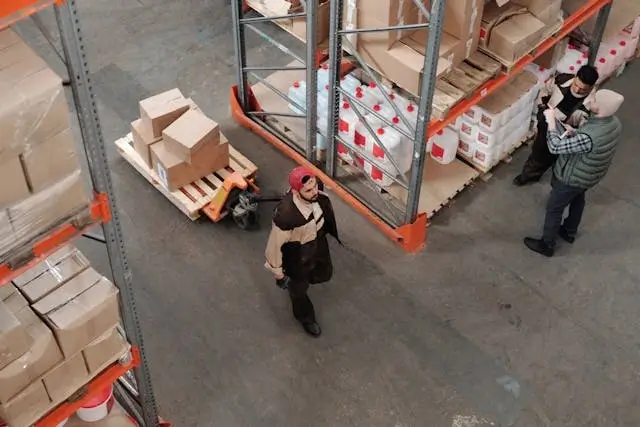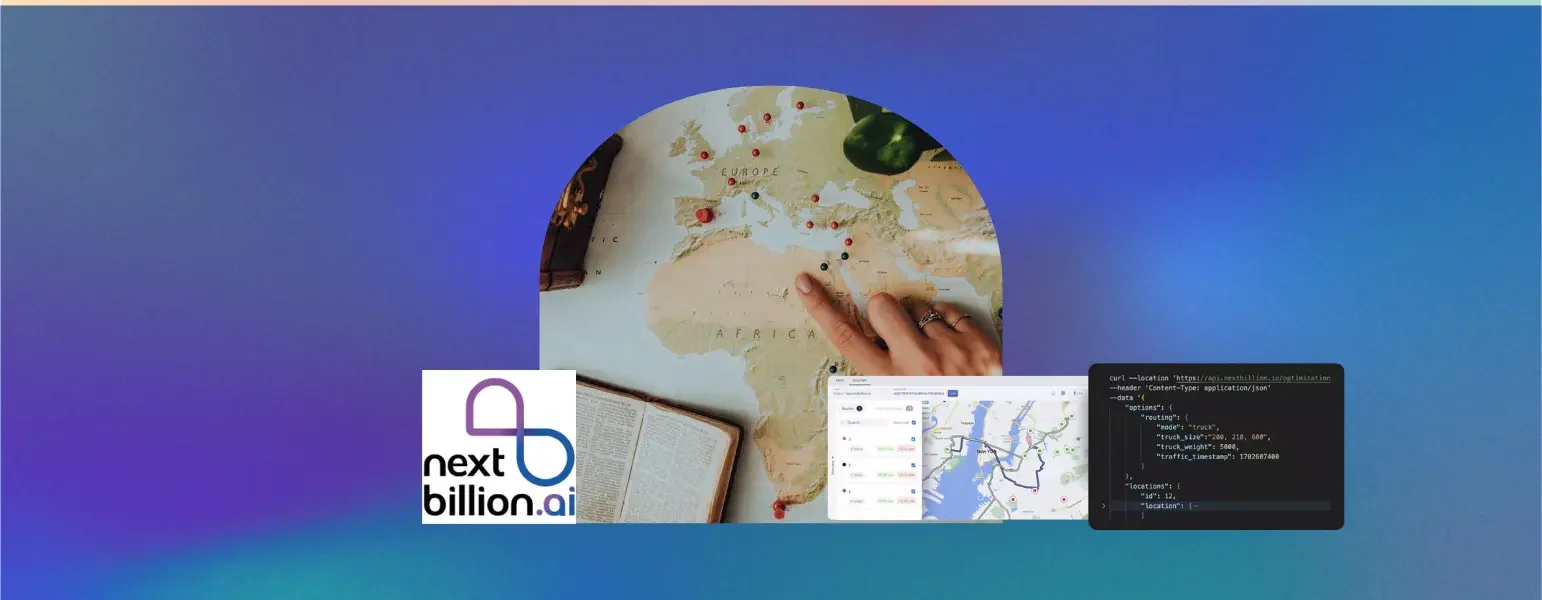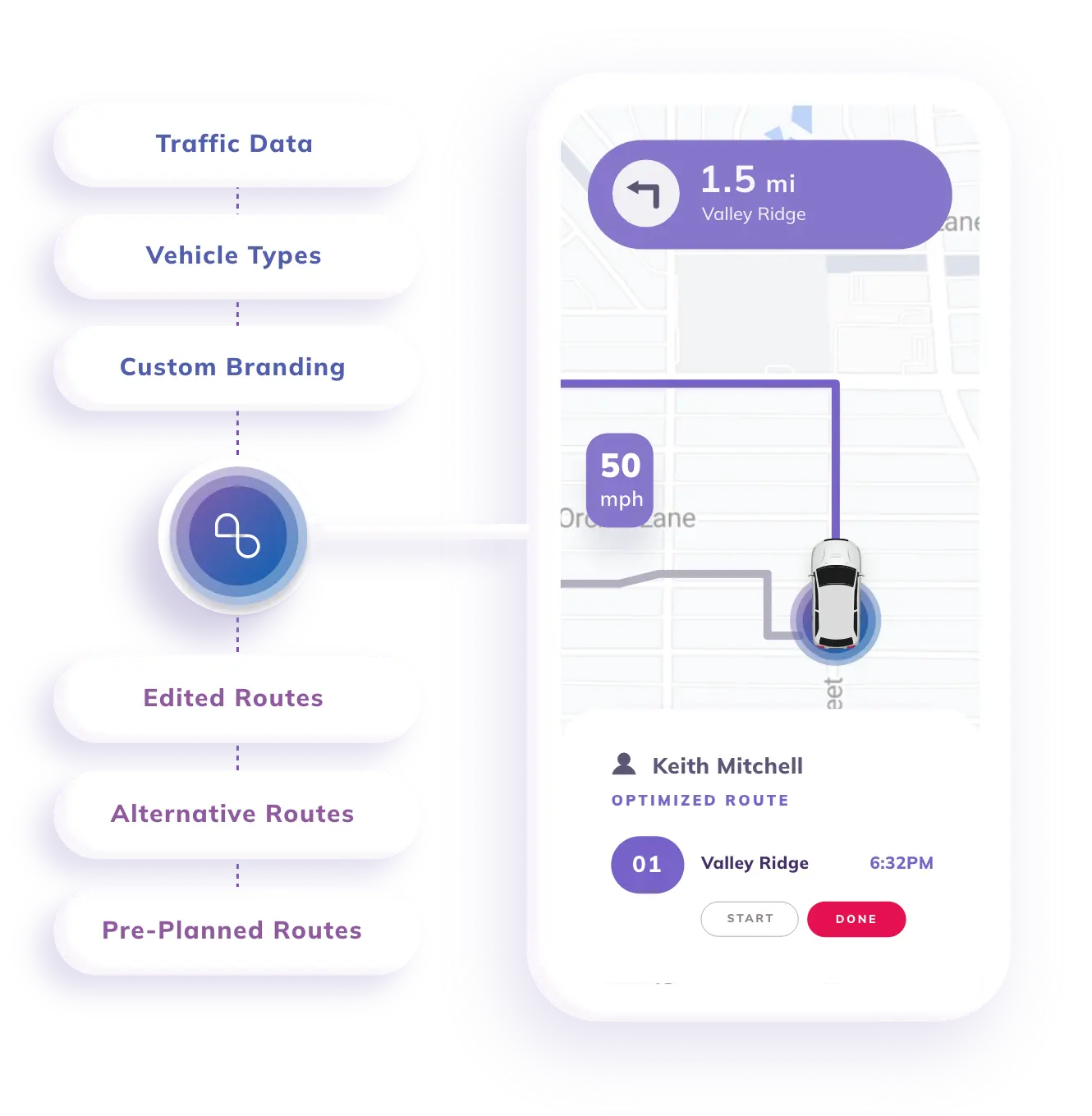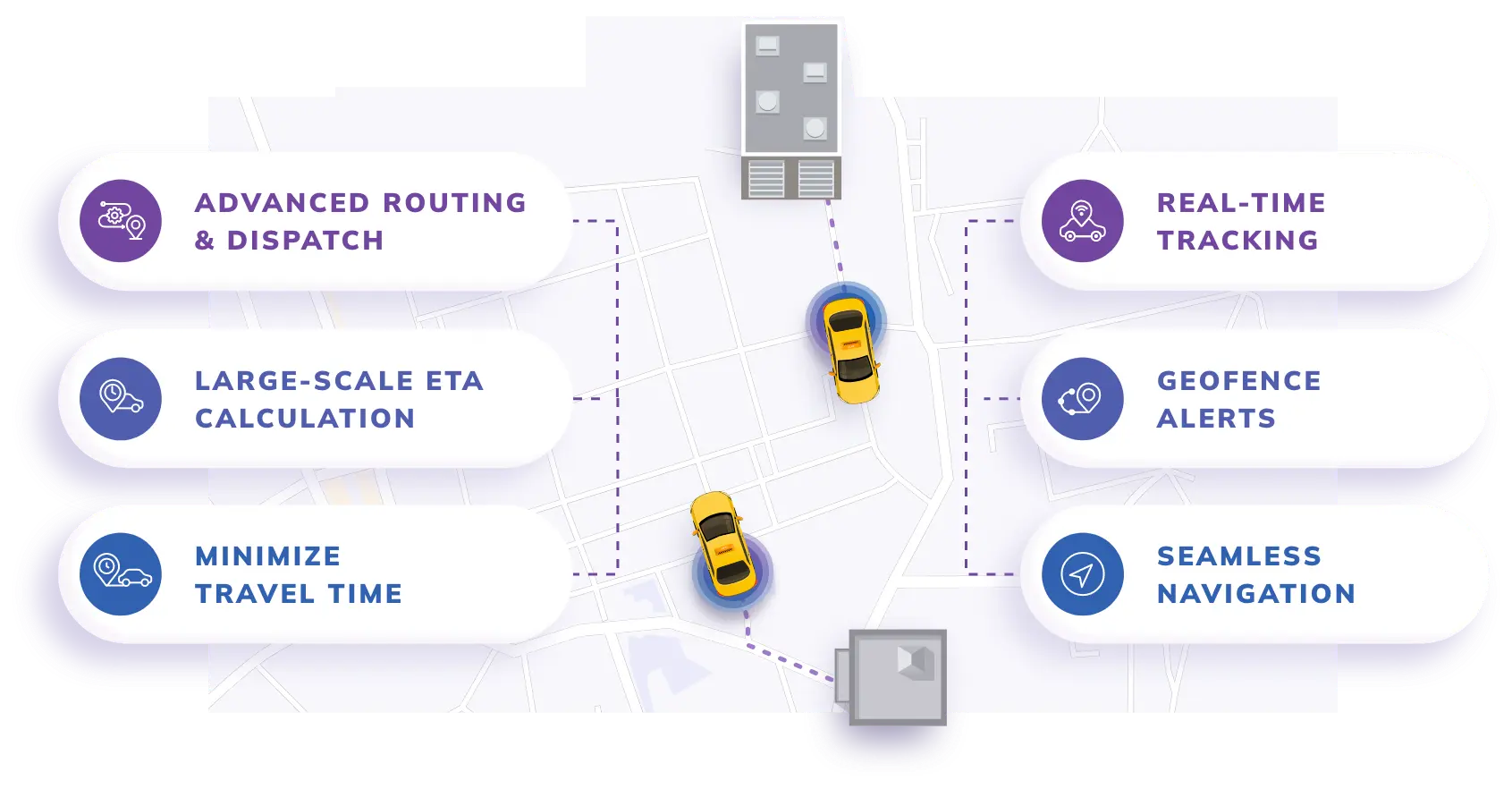

- BLOG
What is Geocoding? (Detailed Guide)
Published: June 30, 2025
Route Optimization API
Optimize routing, task allocation and dispatch
Distance Matrix API
Calculate accurate ETAs, distances and directions
Directions API
Compute routes between two locations
Driver Assignment API
Assign the best driver for every order
Routing & Dispatch App
Plan optimized routes with 50+ Constraints
Product Demos
See NextBillion.ai APIs & SDKs In action
AI Route Optimization
Learns from Your Fleet’s Past Performance
Platform Overview
Learn about how Nextbillion.ai's platform is designed
Road Editor App
Private Routing Preferences For Custom Routing
On-Premise Deployments
Take Full Control of Your Maps and Routing
Trucking
Get regulation-compliant truck routes
Fleet Management
Solve fleet tracking, routing and navigation
Middle Mile Delivery
Optimized supply chain routes
Construction
Routes for Construction Material Delivery
Oil & Gas
Safe & Compliant Routing
Food & Beverage
Plan deliveries of refrigerated goods with regular shipments
Table of Contents

Geocoding is one of those foundational systems that almost every location-based product depends on, but nobody really talks about it unless it breaks. Every time someone opens a map, types in an address, or taps a “locate me” button on a delivery app, there’s a geocoder quietly working behind the scenes, converting that input into latitude and longitude. That part usually works fine, until it doesn’t.
Once you get out of big cities and into the places where addresses are vague, handwritten, spoken differently, or just plain messy, geocoding becomes something else entirely. It’s not just about translating text into coordinates. It’s about figuring out what someone meant when they typed “blue house behind temple” into a checkout form, and making sure a package or person actually ends up there.
If your platform depends on accurate locations, and most do, then your geocoding engine either makes your whole system feel smooth and reliable, or it quietly causes delays, wrong turns, angry users, and support issues. And the worst part is that most of those problems get blamed on drivers, routes, or the app experience, when the real issue started before any of that. It started when the system misunderstood where the user was or where the order was supposed to go.
This guide is for anyone building serious location-aware products. It covers what geocoding is, how it works at a technical level, where the real-world problems show up, and what it actually takes to solve them properly. If you’re building for cities, rural areas, or anywhere in between, and you want your system to hold up under pressure, this is something you need to get right.

Geocoding is the layer between what a person says and what a system understands. When someone types an address, a place name, or just a half-formed location like “near the old bus stop” into an app, the system has to translate that into coordinates. Computers cannot use language to navigate. They need numbers. Geocoding is the process that makes that translation happen.
There are two main directions it works in. Forward geocoding takes an address or place name and returns latitude and longitude. Reverse geocoding takes a set of coordinates and gives back a place label or address that humans can read. Both of these are used constantly by navigation apps, logistics systems, field service platforms, ride-hailing apps, and almost anything that interacts with the real world.
But here’s what people often forget. The real world is not neat. People don’t follow format rules when they type in addresses. Some skip pin codes. Others use local language slang. And in a lot of regions, addresses are not even structured in the first place. A location might just be described as “the blue gate after the petrol pump.” That kind of input completely breaks most default geocoding systems.
This is why solid geocoding is not just about matching strings. It’s about building a system that understands patterns, fills in gaps, makes smart guesses, and returns something usable even when the input is messy.
People only notice geocoding when it goes wrong, but it is one of the most critical parts of any system that interacts with physical places. If the coordinates are off, everything that comes after will suffer. Routes will be longer. Deliveries will be late. Drivers will get confused. Customers will get frustrated. Support calls will go up. None of that happens because the system looks broken on the surface. It all starts quietly with bad location resolution.
If the geocoder understands the region well, and if it can adapt to the way people actually describe locations in that context, everything downstream starts working better. Routing gets faster. Driver apps show the right pickup spots. Estimated times become more accurate. Even analytics becomes cleaner because it’s based on real locations and not guesswork.
That’s why geocoding is not just a backend function. It’s a core piece of infrastructure. When it works properly, nobody notices. When it fails, everything else breaks slowly and silently.
When someone enters a location into your system, it feels like the result appears instantly. But underneath that moment, there’s a layered process that takes that input, breaks it apart, tries to understand what it means, and then gives back something the system can act on. That process is where the quality gets defined.
It starts with parsing. The system tries to figure out what the user typed and splits it into address parts. This might mean identifying the house number, the street name, the locality, and anything else that looks relevant. If someone typed “20 Green Park behind the bakery,” a strong parser should know what is useful and what is extra.
After parsing, the input is normalized. That means abbreviations get expanded, common spellings get corrected, and the pieces are aligned with expected address patterns. This step is critical in regions where people use shorthand or mix languages.
Then the system begins matching. It takes the cleaned-up input and compares it against a database of known addresses, places, and landmarks. If the database is weak, the match will be weak. If the match logic is rigid, it might return the wrong thing or fail completely.
Next comes ranking. Even if multiple results are found, the system has to decide which one is the most likely. It might use the user’s current location, past inputs, frequency of use, or just rules about which locations are more common. This step decides what result the user sees, and it can make or break the experience.
Finally, the result gets returned as coordinates. In better systems, a confidence score is also included so the app can make decisions based on how reliable that result is. If the system is unsure, it might trigger a prompt or request for clarification. If it is confident, the location flows straight into routing or dispatch.
All of this happens in less than a second. But if even one part of that process fails or is built on poor data, the whole chain falls apart quietly in the background.
The most common myth is that clean input always leads to a correct output. That is not how real-world systems behave. Even a well-formatted address can fail if the database is outdated, if the system does not recognize local conventions, or if the match logic favors a more popular but incorrect result.
This is why modern geocoding needs to be smart. It needs to work with fuzzy data. It needs to know the region. And it needs to be designed to keep learning from usage patterns instead of just relying on hard-coded rules.

Geocoding is not just for maps. That’s the biggest misconception. It powers the actual functioning of platforms that move things, move people, or make decisions based on where something is. It sits underneath everything from ride-hailing apps to delivery logistics to emergency services. And when it works well, it makes everything feel seamless. When it fails, the whole experience falls apart and people usually blame the wrong part of the system.

Let’s start with logistics. If your geocoder cannot figure out the exact delivery location, the driver wastes time calling the customer or searching aimlessly. That delay stacks up across the day. Missed deliveries and failed attempts increase. Costs go up. Customers get frustrated. Support tickets pile up.
And this gets worse in markets where addresses are informal. In rural areas or developing cities, people don’t use postal codes or street numbers consistently. They write “house near the water tank” or “back gate of the college.” A good geocoding engine must be able to handle those kinds of instructions and still return something usable.
This is where most people forget geocoding even exists, but it plays a big role. If you’re running a chain of retail stores and you want to understand where your customers are actually located, you have to geocode their addresses first. That lets you create accurate heatmaps, understand catchment areas, and make decisions about where to open your next outlet.
You also need it for hyperlocal ads. If you are running campaigns targeted by neighborhood or by drive-time radius, bad geocoding makes your data completely unreliable. You end up showing ads to the wrong people or missing your actual audience entirely.
Even basic store locator features on websites rely on accurate geocoding. A user searches for nearby branches. If the location is resolved incorrectly, your store list shows the wrong locations. One small failure at the input level causes a lost opportunity to convert.

This is where geocoding stops being a convenience feature and becomes mission critical. If someone sends a location during an emergency, and your system pulls up the wrong address or the wrong side of a large building, it costs time that people do not have.
In cities with large complexes or gated communities, there may be several entrances. Picking the wrong one could delay response teams. In rural zones, addresses might not even exist formally. The system needs to work with coordinates, landmarks, and vague descriptions, and still deliver something useful.
A strong reverse geocoding engine becomes essential here. It has to provide a readable address that responders can use. And it has to be fast. These systems cannot afford to sit around parsing input or guessing based on incomplete data. They need to be tuned for speed, simplicity, and high-stakes accuracy.
There are a lot of geocoding APIs and services out there. Some are good for testing or low-traffic use. Some are good for highly structured data in North American or European formats. But if you’re building something at scale or operating in regions where address inputs are inconsistent, then you need to look much closer at how these tools actually behave under real-world conditions.
Google Maps API
Everyone knows this one. It works well in many countries. It’s stable and easy to integrate. But once you scale up, the cost starts growing fast. You also run into data restrictions. You can’t cache or reuse the results freely in other systems. And it doesn’t handle informal or region-specific address patterns all that well.
Mapbox
Mapbox has clean documentation and offers a more flexible developer experience. It supports good customization and pairs well with vector maps. The geocoding quality is decent in many structured areas but starts to drop in less formal environments. Still, it’s better than many out-of-the-box systems for devs who want control.
HERE Technologies
This is an enterprise-focused platform. The geocoding and routing engines are designed for industries like automotive, supply chain, and field services. It’s stable. It’s reliable. It’s also heavy. You need to know what you’re doing to get the most out of it, and it’s not always the easiest to tune for hyperlocal conditions unless you’re deep into configuration.
Nextbillion.ai
Nextbillion is designed for real-world mess. It was built from the ground up to handle incomplete, local, non-standard addresses and inputs. It allows clients to use their own custom data, train the geocoder on location-specific quirks, and deploy solutions that work where others fail. This is not just about converting text to coordinates. It’s about building something reliable in markets where people don’t follow rules, and where traditional systems break fast.
If you want full control or you need to deploy something on your own servers, open source geocoders are an option. But they require work. These are not plug-and-play tools. You have to manage hosting, indexing, and tuning.

Geocoding has improved a lot, but it is still far from perfect. Anyone working with real-world addresses knows how ugly things get. Most of the issues come from the assumption that users will always give you structured, clean, complete input. They won’t. People type fast, they skip parts, they use local terms that make sense to them and no one else. You have to plan for all of that.
This is the most common and the hardest problem to solve. Many addresses are not unique. You can have ten streets named the same thing across a single city. Some places share names with neighborhoods or businesses. Even when a user gives you something that looks valid, it might not be clear what they meant.
Take something like “Church Road, Bangalore.” There are several Church Roads. Without a postal code, a landmark, or a GPS hint, the system just has to guess. And a wrong guess means a failed delivery or a confused driver. That is not just annoying. That costs money and user trust.
Modern systems deal with this by using context. They use location history, device position, language preference, and nearby known places to figure out what the user probably meant. It is not always perfect, but it is better than just matching strings and hoping for the best.
Another approach is fuzzy matching. The idea is not to wait for a perfect address. The system tries to fill in the blanks, catch spelling errors, and match against common phrasing patterns. Especially in areas where people use informal directions, this makes a huge difference.
Geocoding handles sensitive data. It links people to places. If your system logs every query, stores every address, and lets it sit in a database without control, that is a huge risk. Regulatory bodies are watching location data closely. If your geocoder is not built with privacy in mind, you’re asking for trouble.
Laws like GDPR and CCPA require companies to limit what they collect, process data safely, and give users some control. But it is not just about compliance. Users care about this. They want to know that their location is not being sold, reused, or stored forever without consent.
Some systems now process geocoding on the client side or use encrypted pipelines so that raw location data never leaves the device. Others keep logs for a limited time and strip out personal identifiers. If you are building something long-term, these are not optional features. They need to be built in from the beginning.
If your users are in South Asia, Africa, or the Middle East, they are not going to enter addresses in English every time. You will see inputs in Hindi, Arabic, Tamil, Telugu, and sometimes mixed across scripts. Some are typed phonetically, others are in local spellings. You cannot expect consistency. You cannot expect structure.
A lot of geocoders break the moment a non-Latin script appears. Others cannot handle transliterations or regional slang. This is where machine learning helps. When trained on local data, systems can begin to learn how people refer to places, what shortcuts they use, and which patterns actually matter.
This is also where custom data input comes into play. If your business operates in a specific region, you should be able to plug in your own labeled data to teach the system how addresses work in that environment. You cannot wait for the API to catch up. You have to take control.
Geocoding Case Studies
Let’s drop the theory for a second. These are real examples of how geocoding performs in the wild. Not clean lab environments. Not demo-ready queries. Just actual problems and what worked when things started breaking.
A major ride-hailing platform had constant pickup confusion. Users would set a location and drivers would end up across the street or at the wrong entrance. This happened in cities like Jakarta, Manila, and Bangkok, where informal addresses are common and GPS isn’t always reliable in dense areas.
The system they were using worked well in the US. It completely fell apart here. The geocoder was not tuned for local landmarks, mixed-language inputs, or short-form directions. They switched to a geocoder that had deeper coverage and support for regional patterns. After the switch, missed pickups dropped and customer complaints around location dropped with it. They did not rebuild the app. They just fixed the core issue, which was geocoding.
A delivery company operating in Tier 3 towns and remote areas was dealing with constant address failures. Their customers did not use pin codes. They entered things like “next to the yellow temple” or “across from Sharma tea shop.” The system could not locate half of the orders.
They integrated a geocoder that could be trained on their past delivery data. Over time, the engine learned what people meant when they typed vague instructions. It filled in missing parts, matched based on pattern recognition, and got smarter with every successful delivery. As a result, first-attempt deliveries increased. Driver confusion dropped. And support calls about address problems fell sharply.
An NGO working in disaster zones needed to locate incidents quickly. Many of the areas had no proper addresses. People would send reports with a few words or GPS coordinates from damaged phones. They had to act fast and get as close as possible.
They used a geocoder that could blend open data like OpenStreetMap with custom overlays. This gave their field teams a better sense of where to send people, even when the input was messy or partial. It wasn’t perfect, but it gave them enough to act on. In that kind of work, that is what counts.

Geocoding is not a solved problem. It is just getting started. As the real world becomes more digitized, and more systems rely on location to function, the pressure on geocoding engines will keep increasing. What works today might hold up for a while, but the way people interact with maps and places is changing fast. The tools need to evolve with it.
Most traditional geocoders follow a set of fixed rules. You give them input, and they try to match it against a database using structured logic. That works fine for formatted addresses and clean data. It falls apart the minute people start typing in vague or broken inputs, which is what happens every single day on production systems.
AI is changing that. With machine learning models trained on real-world user inputs, geocoders can start predicting intent instead of just matching patterns. They can learn how people refer to locations in specific cities or languages. They can prioritize matches based on behavior instead of just string comparison.
This shift means the geocoder becomes less like a lookup tool and more like a recommendation engine. It stops waiting for perfect input and starts helping the user complete their intent faster. And it does that based on context, not just logic.
Most geocoding systems still work on the assumption that a location is defined by latitude and longitude on a flat surface. But that does not hold up anymore. In dense urban areas, vertical space matters. A delivery to the fifth floor of Tower B is not the same as a delivery to the ground floor of Tower A next door.
Indoor positioning is going to become part of core geocoding. Systems will start factoring in floor levels, building entrances, and even specific zones inside large campuses or venues. It will not just be about arriving at a building. It will be about arriving at the correct door inside that building.
This kind of detail will matter more as e-commerce grows, as deliveries get faster, and as smart buildings become more common.
Geolocation data is sensitive. It tracks real people in real time. As users become more aware of how this data is collected and used, the systems behind it need to change. You cannot build location systems today without considering privacy from the ground up.
Expect to see more geocoding engines that work locally on the device. More use of anonymous tokens. More data expiration policies that clear logs automatically. And stronger encryption everywhere location is stored or processed.
It is not just about checking compliance boxes. It is about building trust into the system by default.
In the next phase, geocoding will not be a one-time lookup. It will be part of a continuous spatial system that tracks and adjusts based on real-time data. In smart cities, autonomous delivery networks, or IoT-driven environments, the system needs to constantly resolve positions and relationships between moving objects.
That means geocoding engines will need to be faster, more dynamic, and deeply integrated into everything from traffic signals to drones to facility management platforms. Location is not static anymore. Neither is the data that defines it.
Geocoding is one of those things that people treat like it just works in the background until it doesn’t. And when it doesn’t, it quietly wrecks everything that depends on it. If the address isn’t resolved correctly, your entire routing system is already starting from the wrong place. Your delivery or pickup is delayed, your customer support starts getting hit with complaints, and your operations team spends their time guessing which corner or lane the app actually sent someone to.
You can have the best fleet tracking, smooth UI, beautiful maps, and all the optimizations in the world, but if the coordinates behind the scenes are wrong or slightly off or based on the wrong assumption about the address, then the whole flow breaks before it even starts. This is not just a backend step. This is core functionality that drives the physical accuracy of your product or service.
The problem is that most general-purpose geocoders are not built for real-world data. They’re built for clean, structured addresses, written by someone who knows the proper format. That’s not how people type things in real life. That’s not how addresses are written in a lot of countries. A good geocoder should expect garbage input, should handle landmarks and spelling mistakes, should understand local abbreviations, and should not collapse the moment a house number is missing. It should learn. It should adapt. It should hold up under pressure when scale hits or when the data starts getting weird.
If you’re running a platform that depends on moving anything from point A to B, or if you’re building something that interacts with the real world in any form, then your geocoding engine should not be treated like an afterthought. It should be something you invest in early and tune for the places where your users actually live and work.
That’s what makes the difference between “this kind of works most of the time” and “this system is tight and reliable even in messy environments.”
If you’re building for regions where addresses break the rules, Nextbillion.ai offers geocoding that adapts to local context. It learns from your own data and handles the messy inputs others can’t. For platforms that need precision where it matters most, it’s worth a closer look.
They do it by taking rough or incomplete location descriptions and turning them into usable coordinates that can be fed into route planning systems. Instead of relying on perfect addresses, the system learns what kind of inputs are typical in rural zones and adapts routing accordingly, which saves time, fuel, and failed attempts.
The biggest problems show up where formal addressing doesn’t exist, or when the address data is so inconsistent that a system built for clean inputs just can’t keep up. Roads may not show up on standard maps, house numbers might not follow a sequence, people reference landmarks that aren’t part of any public database, and mobile network coverage might be unreliable, making real-time corrections harder to pull off.
They combine geocoding with learned delivery history, customer behavior patterns, and local context. The system doesn’t wait for clean data. It actively makes sense of vague directions, optimizes route clustering even when addresses are informal, and helps the driver reach the customer without needing to call and ask for instructions every time. Over time, the system gets more accurate based on what worked, not just what was written.
Bhavisha Bhatia is a Computer Science graduate with a passion for writing technical blogs that make complex technical concepts engaging and easy to understand. She is intrigued by the technological developments shaping the course of the world and the beautiful nature around us.